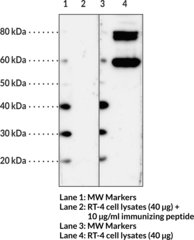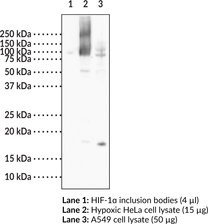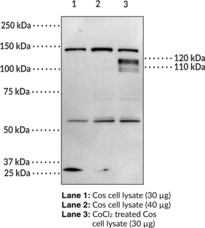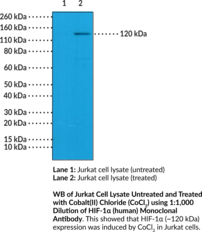Cayman
Showing 23701–23850 of 45550 results
-
Hexadecanal is the 16-carbon free fatty aldehyde analog of palmitic acid that, in conjunction with NAD+, acts as a substrate for hexadecanal:NAD+ oxidoreductase (fatty aldehyde dehydrogenase).{26611}
Brand:CaymanSKU:9001996 - 500 mgAvailable on backorder
Hexadecanamide is a primary fatty acid amide that is derived from palmitic acid (C16:0) (Item No. 10006627) and belongs to a class of important cell signaling lipids.{33153} While the physiological significance of this compound is not yet clear, it is reported to demonstrate weak anticonvulsant activity in a maximal electroshock seizure test in mice when compared with the endocannabinoid palmitoyl ethanolamide (Item No. 90350).{33154}
Brand:CaymanSKU:21086 -Out of stock
Hexadecanamide is a primary fatty acid amide that is derived from palmitic acid (C16:0) (Item No. 10006627) and belongs to a class of important cell signaling lipids.{33153} While the physiological significance of this compound is not yet clear, it is reported to demonstrate weak anticonvulsant activity in a maximal electroshock seizure test in mice when compared with the endocannabinoid palmitoyl ethanolamide (Item No. 90350).{33154}
Brand:CaymanSKU:21086 -Out of stock
Hexadecanamide is a primary fatty acid amide that is derived from palmitic acid (C16:0) (Item No. 10006627) and belongs to a class of important cell signaling lipids.{33153} While the physiological significance of this compound is not yet clear, it is reported to demonstrate weak anticonvulsant activity in a maximal electroshock seizure test in mice when compared with the endocannabinoid palmitoyl ethanolamide (Item No. 90350).{33154}
Brand:CaymanSKU:21086 -Out of stock
Hexadecanamide is a primary fatty acid amide that is derived from palmitic acid (C16:0) (Item No. 10006627) and belongs to a class of important cell signaling lipids.{33153} While the physiological significance of this compound is not yet clear, it is reported to demonstrate weak anticonvulsant activity in a maximal electroshock seizure test in mice when compared with the endocannabinoid palmitoyl ethanolamide (Item No. 90350).{33154}
Brand:CaymanSKU:21086 -Out of stock
Hexadecyl acetyl glycerol (HAG) is an analog of DAG, which inhibits the activation of PKC by DAG.{7583} It also inhibits the growth of HL-60 cells and induces differentiation to cells resembling mononuclear phagocytes. Following treatment with 5 µg/ml HAG for six days, HL-60 cells demonstrated a 10-fold increase in non-specific esterase activity.{721}
Brand:CaymanSKU:60920 - 10 mgAvailable on backorder
Hexadecyl acetyl glycerol (HAG) is an analog of DAG, which inhibits the activation of PKC by DAG.{7583} It also inhibits the growth of HL-60 cells and induces differentiation to cells resembling mononuclear phagocytes. Following treatment with 5 µg/ml HAG for six days, HL-60 cells demonstrated a 10-fold increase in non-specific esterase activity.{721}
Brand:CaymanSKU:60920 - 100 mgAvailable on backorder
Hexadecyl acetyl glycerol (HAG) is an analog of DAG, which inhibits the activation of PKC by DAG.{7583} It also inhibits the growth of HL-60 cells and induces differentiation to cells resembling mononuclear phagocytes. Following treatment with 5 µg/ml HAG for six days, HL-60 cells demonstrated a 10-fold increase in non-specific esterase activity.{721}
Brand:CaymanSKU:60920 - 5 mgAvailable on backorder
Hexadecyl acetyl glycerol (HAG) is an analog of DAG, which inhibits the activation of PKC by DAG.{7583} It also inhibits the growth of HL-60 cells and induces differentiation to cells resembling mononuclear phagocytes. Following treatment with 5 µg/ml HAG for six days, HL-60 cells demonstrated a 10-fold increase in non-specific esterase activity.{721}
Brand:CaymanSKU:60920 - 50 mgAvailable on backorder
Hexadecyl methyl glycerol is a synthetic diacylglycerol with a hexadecyl chain at the sn-1 position and a methyl group at the sn-2 position. It inhibits protein kinase C activity in human neutrophils, resulting in prevention of the respiratory burst induced by both phorbol 12,13-dibutyrate and fMLP.{357}
Brand:CaymanSKU:60930 - 10 mgAvailable on backorder
Hexadecyl methyl glycerol is a synthetic diacylglycerol with a hexadecyl chain at the sn-1 position and a methyl group at the sn-2 position. It inhibits protein kinase C activity in human neutrophils, resulting in prevention of the respiratory burst induced by both phorbol 12,13-dibutyrate and fMLP.{357}
Brand:CaymanSKU:60930 - 100 mgAvailable on backorder
Hexadecyl methyl glycerol is a synthetic diacylglycerol with a hexadecyl chain at the sn-1 position and a methyl group at the sn-2 position. It inhibits protein kinase C activity in human neutrophils, resulting in prevention of the respiratory burst induced by both phorbol 12,13-dibutyrate and fMLP.{357}
Brand:CaymanSKU:60930 - 50 mgAvailable on backorder
Hexaflumuron is a chitin synthesis inhibitor used to bait and eliminate termite colonies.{33917} Hexaflumuron spreads efficiently through entire populations through mutual exchange of liquids via regurgitation.{33919} Termites are unable to metabolize hexaflumuron and clearance is slow, resulting in up to 100% elimination. Hexaflumuron has also been tested for use with the raisin moth, cowpea weevil, and Asiatic rice borer with positive results.{33918,33915}
Brand:CaymanSKU:-Available on backorder
Hexaflumuron is a chitin synthesis inhibitor used to bait and eliminate termite colonies.{33917} Hexaflumuron spreads efficiently through entire populations through mutual exchange of liquids via regurgitation.{33919} Termites are unable to metabolize hexaflumuron and clearance is slow, resulting in up to 100% elimination. Hexaflumuron has also been tested for use with the raisin moth, cowpea weevil, and Asiatic rice borer with positive results.{33918,33915}
Brand:CaymanSKU:-Available on backorder
Hexaflumuron is a chitin synthesis inhibitor used to bait and eliminate termite colonies.{33917} Hexaflumuron spreads efficiently through entire populations through mutual exchange of liquids via regurgitation.{33919} Termites are unable to metabolize hexaflumuron and clearance is slow, resulting in up to 100% elimination. Hexaflumuron has also been tested for use with the raisin moth, cowpea weevil, and Asiatic rice borer with positive results.{33918,33915}
Brand:CaymanSKU:-Available on backorder
Hexahydrocurcumin is a natural product and glucuronide metabolite of curcumin that has anti-inflammatory, antioxidant, and anticancer properties.{8985} It reduces prostaglandin E2 (PGE2) production stimulated by phorbol 12-myristate 13-acetate (PMA; Item No. 10008014) by 37% in human colonic epithelial cells when used at a concentration of 20 µM. Hexahydrocurcumin (3.125-25 µM) inhibits overproduction of nitric oxide induced by LPS in RAW 264.7 macrophage cells in a concentration-dependent manner.{38854} It does not affect LPS-induced cytokine release but inhibits LPS-induced iNOS and COX-2 upregulation and NF-κB activation when used at a concentration of 50 µM. Hexahydrocurcumin prevents the formation of aberrant crypt foci in a dimethylhydrazine rat model of colon cancer and potentiates the effect of 5-fluorouracil (Item No. 14416).{38855}
Brand:CaymanSKU:11714 - 1 mgAvailable on backorder
Hexahydrocurcumin is a natural product and glucuronide metabolite of curcumin that has anti-inflammatory, antioxidant, and anticancer properties.{8985} It reduces prostaglandin E2 (PGE2) production stimulated by phorbol 12-myristate 13-acetate (PMA; Item No. 10008014) by 37% in human colonic epithelial cells when used at a concentration of 20 µM. Hexahydrocurcumin (3.125-25 µM) inhibits overproduction of nitric oxide induced by LPS in RAW 264.7 macrophage cells in a concentration-dependent manner.{38854} It does not affect LPS-induced cytokine release but inhibits LPS-induced iNOS and COX-2 upregulation and NF-κB activation when used at a concentration of 50 µM. Hexahydrocurcumin prevents the formation of aberrant crypt foci in a dimethylhydrazine rat model of colon cancer and potentiates the effect of 5-fluorouracil (Item No. 14416).{38855}
Brand:CaymanSKU:11714 - 10 mgAvailable on backorder
Hexahydrocurcumin is a natural product and glucuronide metabolite of curcumin that has anti-inflammatory, antioxidant, and anticancer properties.{8985} It reduces prostaglandin E2 (PGE2) production stimulated by phorbol 12-myristate 13-acetate (PMA; Item No. 10008014) by 37% in human colonic epithelial cells when used at a concentration of 20 µM. Hexahydrocurcumin (3.125-25 µM) inhibits overproduction of nitric oxide induced by LPS in RAW 264.7 macrophage cells in a concentration-dependent manner.{38854} It does not affect LPS-induced cytokine release but inhibits LPS-induced iNOS and COX-2 upregulation and NF-κB activation when used at a concentration of 50 µM. Hexahydrocurcumin prevents the formation of aberrant crypt foci in a dimethylhydrazine rat model of colon cancer and potentiates the effect of 5-fluorouracil (Item No. 14416).{38855}
Brand:CaymanSKU:11714 - 5 mgAvailable on backorder
Hexamethonium is a peripherally-acting nondepolarizing neuromuscular blocking agent that acts as an antagonist of nicotinic acetylcholine receptors (nAChRs).{46022,46021} It decreases acetylcholine release induced by carbamoylcholine (Item No. 14486) in isolated cat superior cervical ganglion when used at concentrations of 27.4 and 54.8 µg/ml.{46023} It also decreases mean arterial pressure in unanesthetized rats when administered at a dose of 40 mg/kg.{46024} Intraventricular administration of hexamethonium (18 ng, i.c.v.) induces signs of nicotine abstinence, including shaking, writhing, and chewing in nicotine-dependent rats.{46025} Formulations containing hexamethonium were previously used in the treatment of hypertension.
Brand:CaymanSKU:25505 - 10 gAvailable on backorder
Hexamethonium is a peripherally-acting nondepolarizing neuromuscular blocking agent that acts as an antagonist of nicotinic acetylcholine receptors (nAChRs).{46022,46021} It decreases acetylcholine release induced by carbamoylcholine (Item No. 14486) in isolated cat superior cervical ganglion when used at concentrations of 27.4 and 54.8 µg/ml.{46023} It also decreases mean arterial pressure in unanesthetized rats when administered at a dose of 40 mg/kg.{46024} Intraventricular administration of hexamethonium (18 ng, i.c.v.) induces signs of nicotine abstinence, including shaking, writhing, and chewing in nicotine-dependent rats.{46025} Formulations containing hexamethonium were previously used in the treatment of hypertension.
Brand:CaymanSKU:25505 - 100 gAvailable on backorder
Hexamethonium is a peripherally-acting nondepolarizing neuromuscular blocking agent that acts as an antagonist of nicotinic acetylcholine receptors (nAChRs).{46022,46021} It decreases acetylcholine release induced by carbamoylcholine (Item No. 14486) in isolated cat superior cervical ganglion when used at concentrations of 27.4 and 54.8 µg/ml.{46023} It also decreases mean arterial pressure in unanesthetized rats when administered at a dose of 40 mg/kg.{46024} Intraventricular administration of hexamethonium (18 ng, i.c.v.) induces signs of nicotine abstinence, including shaking, writhing, and chewing in nicotine-dependent rats.{46025} Formulations containing hexamethonium were previously used in the treatment of hypertension.
Brand:CaymanSKU:25505 - 25 gAvailable on backorder
Hexamethonium is a peripherally-acting nondepolarizing neuromuscular blocking agent that acts as an antagonist of nicotinic acetylcholine receptors (nAChRs).{46022,46021} It decreases acetylcholine release induced by carbamoylcholine (Item No. 14486) in isolated cat superior cervical ganglion when used at concentrations of 27.4 and 54.8 µg/ml.{46023} It also decreases mean arterial pressure in unanesthetized rats when administered at a dose of 40 mg/kg.{46024} Intraventricular administration of hexamethonium (18 ng, i.c.v.) induces signs of nicotine abstinence, including shaking, writhing, and chewing in nicotine-dependent rats.{46025} Formulations containing hexamethonium were previously used in the treatment of hypertension.
Brand:CaymanSKU:25505 - 5 gAvailable on backorder
Hexaminolevulinate is a lipophilic, hexyl ester prodrug form of 5-aminolevulinic acid (Item No. 9001902).{40686} It produces equivalent protoporphyrin IX (PpIX) induction in WiDr and NHIK 3025 carcinoma cells at concentrations approximately 100-fold lower than 5-aminolevulinic acid. In vivo, hexaminolevulinate penetrates upper skin layers more effectively in pigs and induces higher levels of PpIX fluorescence in nude mice when compared with 5-aminolevulinic acid following topical administration.{40687} Formulations containing hexaminolevulinate have been used in imaging and photodynamic therapy for a variety of urogenital cancers.
Brand:CaymanSKU:23949 - 1 gAvailable on backorder
Hexaminolevulinate is a lipophilic, hexyl ester prodrug form of 5-aminolevulinic acid (Item No. 9001902).{40686} It produces equivalent protoporphyrin IX (PpIX) induction in WiDr and NHIK 3025 carcinoma cells at concentrations approximately 100-fold lower than 5-aminolevulinic acid. In vivo, hexaminolevulinate penetrates upper skin layers more effectively in pigs and induces higher levels of PpIX fluorescence in nude mice when compared with 5-aminolevulinic acid following topical administration.{40687} Formulations containing hexaminolevulinate have been used in imaging and photodynamic therapy for a variety of urogenital cancers.
Brand:CaymanSKU:23949 - 250 mgAvailable on backorder
Hexaminolevulinate is a lipophilic, hexyl ester prodrug form of 5-aminolevulinic acid (Item No. 9001902).{40686} It produces equivalent protoporphyrin IX (PpIX) induction in WiDr and NHIK 3025 carcinoma cells at concentrations approximately 100-fold lower than 5-aminolevulinic acid. In vivo, hexaminolevulinate penetrates upper skin layers more effectively in pigs and induces higher levels of PpIX fluorescence in nude mice when compared with 5-aminolevulinic acid following topical administration.{40687} Formulations containing hexaminolevulinate have been used in imaging and photodynamic therapy for a variety of urogenital cancers.
Brand:CaymanSKU:23949 - 500 mgAvailable on backorder
Hexanoic acid-d11 is intended for use as an internal standard for the quantification of hexanoic acid by GC- or LC-MS. Hexanoic acid is a short-chain saturated fatty acid that has been found in various animal fats used in biodiesel production.{51107}
Brand:CaymanSKU:28082 - 1 gAvailable on backorder
Hexanoic acid-d11 is intended for use as an internal standard for the quantification of hexanoic acid by GC- or LC-MS. Hexanoic acid is a short-chain saturated fatty acid that has been found in various animal fats used in biodiesel production.{51107}
Brand:CaymanSKU:28082 - 100 mgAvailable on backorder
Hexanoic acid-d11 is intended for use as an internal standard for the quantification of hexanoic acid by GC- or LC-MS. Hexanoic acid is a short-chain saturated fatty acid that has been found in various animal fats used in biodiesel production.{51107}
Brand:CaymanSKU:28082 - 250 mgAvailable on backorder
Hexanoic acid-d11 is intended for use as an internal standard for the quantification of hexanoic acid by GC- or LC-MS. Hexanoic acid is a short-chain saturated fatty acid that has been found in various animal fats used in biodiesel production.{51107}
Brand:CaymanSKU:28082 - 500 mgAvailable on backorder
Hexanoic acid-d3 is intended for use as an internal standard for the quantification of hexanoic acid by GC- or LC-MS. Hexanoic acid is a short-chain saturated fatty acid that has been found in various animal fats used in biodiesel production.{51107}
Brand:CaymanSKU:28497 - 10 mgAvailable on backorder
Hexanoic acid-d3 is intended for use as an internal standard for the quantification of hexanoic acid by GC- or LC-MS. Hexanoic acid is a short-chain saturated fatty acid that has been found in various animal fats used in biodiesel production.{51107}
Brand:CaymanSKU:28497 - 100 mgAvailable on backorder
Hexanoic acid-d3 is intended for use as an internal standard for the quantification of hexanoic acid by GC- or LC-MS. Hexanoic acid is a short-chain saturated fatty acid that has been found in various animal fats used in biodiesel production.{51107}
Brand:CaymanSKU:28497 - 250 mgAvailable on backorder
Hexanoic acid-d3 is intended for use as an internal standard for the quantification of hexanoic acid by GC- or LC-MS. Hexanoic acid is a short-chain saturated fatty acid that has been found in various animal fats used in biodiesel production.{51107}
Brand:CaymanSKU:28497 - 50 mgAvailable on backorder
Hexanolamino PAF C-16 is a PAF analog with mixed agonist/antagonist properties. In human monocyte-derived macrophages, it is an antagonist which inhibits the production of reactive oxygen species in response to PAF C-16.{367} On the other hand, in rabbit platelets and guinea pig macrophages, hexanolamino PAF C-16 is a partial agonist, and in guinea pig platelets it is a full agonist.{3786}
Brand:CaymanSKU:60905 - 1 mgAvailable on backorder
Hexanolamino PAF C-16 is a PAF analog with mixed agonist/antagonist properties. In human monocyte-derived macrophages, it is an antagonist which inhibits the production of reactive oxygen species in response to PAF C-16.{367} On the other hand, in rabbit platelets and guinea pig macrophages, hexanolamino PAF C-16 is a partial agonist, and in guinea pig platelets it is a full agonist.{3786}
Brand:CaymanSKU:60905 - 10 mgAvailable on backorder
Hexanolamino PAF C-16 is a PAF analog with mixed agonist/antagonist properties. In human monocyte-derived macrophages, it is an antagonist which inhibits the production of reactive oxygen species in response to PAF C-16.{367} On the other hand, in rabbit platelets and guinea pig macrophages, hexanolamino PAF C-16 is a partial agonist, and in guinea pig platelets it is a full agonist.{3786}
Brand:CaymanSKU:60905 - 25 mgAvailable on backorder
Hexanolamino PAF C-16 is a PAF analog with mixed agonist/antagonist properties. In human monocyte-derived macrophages, it is an antagonist which inhibits the production of reactive oxygen species in response to PAF C-16.{367} On the other hand, in rabbit platelets and guinea pig macrophages, hexanolamino PAF C-16 is a partial agonist, and in guinea pig platelets it is a full agonist.{3786}
Brand:CaymanSKU:60905 - 5 mgAvailable on backorder
Hexanoyl glycine is an acylated amino acid that is used as a urinary biomarker for several indications. It is normally biosynthesized from hexanoyl-CoA and glycine by the mitochondrial enzyme glycine N-acyltransferase. Increased urinary excretion of hexanoyl glycine in humans is indicative of a deficiency in medium-chain acyl-CoA dehydrogenase.{26849,26850} Increased urinary hexanoyl glycine can also be used as a biomarker for exposure to gamma radiation.{26851} Levels of hexanyl glycine can also be elevated during cancer, while they are decreased 20-fold in mice following treatment with the PPARα ligand Wy 14643(Item No. 70730).{26848,26852}
Brand:CaymanSKU:-Out of stock
Hexanoyl glycine is an acylated amino acid that is used as a urinary biomarker for several indications. It is normally biosynthesized from hexanoyl-CoA and glycine by the mitochondrial enzyme glycine N-acyltransferase. Increased urinary excretion of hexanoyl glycine in humans is indicative of a deficiency in medium-chain acyl-CoA dehydrogenase.{26849,26850} Increased urinary hexanoyl glycine can also be used as a biomarker for exposure to gamma radiation.{26851} Levels of hexanyl glycine can also be elevated during cancer, while they are decreased 20-fold in mice following treatment with the PPARα ligand Wy 14643(Item No. 70730).{26848,26852}
Brand:CaymanSKU:-Out of stock
Hexanoyl glycine is an acylated amino acid that is used as a urinary biomarker for several indications. It is normally biosynthesized from hexanoyl-CoA and glycine by the mitochondrial enzyme glycine N-acyltransferase. Increased urinary excretion of hexanoyl glycine in humans is indicative of a deficiency in medium-chain acyl-CoA dehydrogenase.{26849,26850} Increased urinary hexanoyl glycine can also be used as a biomarker for exposure to gamma radiation.{26851} Levels of hexanyl glycine can also be elevated during cancer, while they are decreased 20-fold in mice following treatment with the PPARα ligand Wy 14643(Item No. 70730).{26848,26852}
Brand:CaymanSKU:-Out of stock
Hexanoyl glycine is an acylated amino acid that is used as a urinary biomarker for several indications. It is normally biosynthesized from hexanoyl-CoA and glycine by the mitochondrial enzyme glycine N-acyltransferase. Increased urinary excretion of hexanoyl glycine in humans is indicative of a deficiency in medium-chain acyl-CoA dehydrogenase.{26849,26850} Increased urinary hexanoyl glycine can also be used as a biomarker for exposure to gamma radiation.{26851} Levels of hexanyl glycine can also be elevated during cancer, while they are decreased 20-fold in mice following treatment with the PPARα ligand Wy 14643(Item No. 70730).{26848,26852}
Brand:CaymanSKU:-Out of stock
Hexanoyl-L-carnitine is a medium-chain acylcarnitine. It has been used in the synthesis of acylcarnitine benzyl esters.{43574}
Brand:CaymanSKU:26554 - 10 mgAvailable on backorder
Hexanoyl-L-carnitine is a medium-chain acylcarnitine. It has been used in the synthesis of acylcarnitine benzyl esters.{43574}
Brand:CaymanSKU:26554 - 25 mgAvailable on backorder
Hexanoyl-L-carnitine is a medium-chain acylcarnitine. It has been used in the synthesis of acylcarnitine benzyl esters.{43574}
Brand:CaymanSKU:26554 - 5 mgAvailable on backorder
Hexanoyl-L-carnitine is a medium-chain acylcarnitine. It has been used in the synthesis of acylcarnitine benzyl esters.{43574}
Brand:CaymanSKU:26554 - 50 mgAvailable on backorder
Hexestrol is a synthetic non-steroidal estrogen receptor ligand that binds to estrogen receptor α (ERα) and ERβ (Kis = 0.06 and 0.06 nM for the human and rat receptors, respectively).{23592} It inhibits rat liver microsomal and ox brain phospholipid liposomal lipid peroxidation (IC50s = 1.5 and 2.75 μM, respectively).{45569} It also inhibits porcine microtubule assembly and induces disassembly of preformed microtubules when used at concentrations of 50 and 100 μM, respectively, in a cell-free assay.{45571} Hexestrol (25 mg/animal) induces kidney tumors in male Syrian hamsters.{45570}
Brand:CaymanSKU:29003 - 1 gAvailable on backorder
Hexestrol is a synthetic non-steroidal estrogen receptor ligand that binds to estrogen receptor α (ERα) and ERβ (Kis = 0.06 and 0.06 nM for the human and rat receptors, respectively).{23592} It inhibits rat liver microsomal and ox brain phospholipid liposomal lipid peroxidation (IC50s = 1.5 and 2.75 μM, respectively).{45569} It also inhibits porcine microtubule assembly and induces disassembly of preformed microtubules when used at concentrations of 50 and 100 μM, respectively, in a cell-free assay.{45571} Hexestrol (25 mg/animal) induces kidney tumors in male Syrian hamsters.{45570}
Brand:CaymanSKU:29003 - 500 mgAvailable on backorder
Hexylglutathione is a mitochondrial membrane-bound microsomal glutathione S-transferase 1 (mtMGST1) inhibitor (IC50 = 0.48 mM).{49426} It also inhibits the dopachrome tautomerase activity of macrophage migration inhibitory factor (MIF; IC50 = 3.3 mM).{49427} It has been used as an affinity chromatography ligand to purify glutathione S-transferase (GST) from sheep liver homogenate.{49428}
Brand:CaymanSKU:29695 - 100 mgAvailable on backorder
Hexylglutathione is a mitochondrial membrane-bound microsomal glutathione S-transferase 1 (mtMGST1) inhibitor (IC50 = 0.48 mM).{49426} It also inhibits the dopachrome tautomerase activity of macrophage migration inhibitory factor (MIF; IC50 = 3.3 mM).{49427} It has been used as an affinity chromatography ligand to purify glutathione S-transferase (GST) from sheep liver homogenate.{49428}
Brand:CaymanSKU:29695 - 250 mgAvailable on backorder
Hexylglutathione is a mitochondrial membrane-bound microsomal glutathione S-transferase 1 (mtMGST1) inhibitor (IC50 = 0.48 mM).{49426} It also inhibits the dopachrome tautomerase activity of macrophage migration inhibitory factor (MIF; IC50 = 3.3 mM).{49427} It has been used as an affinity chromatography ligand to purify glutathione S-transferase (GST) from sheep liver homogenate.{49428}
Brand:CaymanSKU:29695 - 500 mgAvailable on backorder
Hexythiazox is an acaricide that induces toxicity in larvae of the two-spotted spider mite T. urticae and the European red mite P. ulmi (LC50s = 0.15-0.58 and 0.23-0.62 mg AI/L, respectively), as well as in the summer and winter eggs of P. ulmi (LC50s = 2.2 and 20 ppm, respectively).{43326,43327} Hexythiazox is toxic to bluegill (L. macrochirus; LC50 = 3.2 mg/L) and D. magna (EC50 = 0.36 mg/L) but not rats (LD50 = >5,000 mg/kg).{43328} Formulations containing hexythiazox have been used in the control of mites in agriculture.
Brand:CaymanSKU:25626 - 100 mgAvailable on backorder
Hexythiazox is an acaricide that induces toxicity in larvae of the two-spotted spider mite T. urticae and the European red mite P. ulmi (LC50s = 0.15-0.58 and 0.23-0.62 mg AI/L, respectively), as well as in the summer and winter eggs of P. ulmi (LC50s = 2.2 and 20 ppm, respectively).{43326,43327} Hexythiazox is toxic to bluegill (L. macrochirus; LC50 = 3.2 mg/L) and D. magna (EC50 = 0.36 mg/L) but not rats (LD50 = >5,000 mg/kg).{43328} Formulations containing hexythiazox have been used in the control of mites in agriculture.
Brand:CaymanSKU:25626 - 50 mgAvailable on backorder
HG-10-102-01 is an inhibitor of leucine-rich repeat kinase 2 (LRRK2; IC50 = 20.3 nM).{33361} It also inhibits the G2019S, A2016T, and [G2019S+A2016T] mutants of LRRK2 (IC50s = 3.2, 153, and 95.9 nM, respectively).{33361} HG-10-102-01 substantially inhibits Ser910 and Ser935 phosphorylation of both wild-type and G2019S mutant LRRK2 in cells. When given intraperitoneally, HG-10-102-01 penetrates the blood-brain barrier and inhibits phosphorylation of LRRK2 in the brain as well as the kidney and spleen.{33361}
Brand:CaymanSKU:20049 -Available on backorder
HG-10-102-01 is an inhibitor of leucine-rich repeat kinase 2 (LRRK2; IC50 = 20.3 nM).{33361} It also inhibits the G2019S, A2016T, and [G2019S+A2016T] mutants of LRRK2 (IC50s = 3.2, 153, and 95.9 nM, respectively).{33361} HG-10-102-01 substantially inhibits Ser910 and Ser935 phosphorylation of both wild-type and G2019S mutant LRRK2 in cells. When given intraperitoneally, HG-10-102-01 penetrates the blood-brain barrier and inhibits phosphorylation of LRRK2 in the brain as well as the kidney and spleen.{33361}
Brand:CaymanSKU:20049 -Available on backorder
HG-10-102-01 is an inhibitor of leucine-rich repeat kinase 2 (LRRK2; IC50 = 20.3 nM).{33361} It also inhibits the G2019S, A2016T, and [G2019S+A2016T] mutants of LRRK2 (IC50s = 3.2, 153, and 95.9 nM, respectively).{33361} HG-10-102-01 substantially inhibits Ser910 and Ser935 phosphorylation of both wild-type and G2019S mutant LRRK2 in cells. When given intraperitoneally, HG-10-102-01 penetrates the blood-brain barrier and inhibits phosphorylation of LRRK2 in the brain as well as the kidney and spleen.{33361}
Brand:CaymanSKU:20049 -Available on backorder
HG-10-102-01 is an inhibitor of leucine-rich repeat kinase 2 (LRRK2; IC50 = 20.3 nM).{33361} It also inhibits the G2019S, A2016T, and [G2019S+A2016T] mutants of LRRK2 (IC50s = 3.2, 153, and 95.9 nM, respectively).{33361} HG-10-102-01 substantially inhibits Ser910 and Ser935 phosphorylation of both wild-type and G2019S mutant LRRK2 in cells. When given intraperitoneally, HG-10-102-01 penetrates the blood-brain barrier and inhibits phosphorylation of LRRK2 in the brain as well as the kidney and spleen.{33361}
Brand:CaymanSKU:20049 -Available on backorder
Brand:CaymanSKU:22984 - 1 mgAvailable on backorder
Brand:CaymanSKU:22984 - 10 mgAvailable on backorder
Brand:CaymanSKU:22984 - 25 mgAvailable on backorder
Brand:CaymanSKU:22984 - 5 mgAvailable on backorder
HG-9-91-01 is an inhibitor of salt-inducible kinases (SIKs; IC50s = 0.92, 6.6, and 9.6 nM for SIK1, SIK2, and SIK3, respectively).{30901} It also inhibits Src, Lck, Yes, and BTK, as well as FGF and Ephrin receptors.{30901} HG-9-91-01 increases LPS-stimulated IL-10 production and suppresses pro-inflammatory cytokine secretion in bone marrow-derived macrophages.{30901} SIK inhibitors, including HG-9-91-01, enhance CREB-dependent gene transcription and IL-10 production in bone marrow-derived dendritic cells, THP-1 cells, and human primary macrophages.{30901}
Brand:CaymanSKU:-Available on backorder
HG-9-91-01 is an inhibitor of salt-inducible kinases (SIKs; IC50s = 0.92, 6.6, and 9.6 nM for SIK1, SIK2, and SIK3, respectively).{30901} It also inhibits Src, Lck, Yes, and BTK, as well as FGF and Ephrin receptors.{30901} HG-9-91-01 increases LPS-stimulated IL-10 production and suppresses pro-inflammatory cytokine secretion in bone marrow-derived macrophages.{30901} SIK inhibitors, including HG-9-91-01, enhance CREB-dependent gene transcription and IL-10 production in bone marrow-derived dendritic cells, THP-1 cells, and human primary macrophages.{30901}
Brand:CaymanSKU:-Available on backorder
HG-9-91-01 is an inhibitor of salt-inducible kinases (SIKs; IC50s = 0.92, 6.6, and 9.6 nM for SIK1, SIK2, and SIK3, respectively).{30901} It also inhibits Src, Lck, Yes, and BTK, as well as FGF and Ephrin receptors.{30901} HG-9-91-01 increases LPS-stimulated IL-10 production and suppresses pro-inflammatory cytokine secretion in bone marrow-derived macrophages.{30901} SIK inhibitors, including HG-9-91-01, enhance CREB-dependent gene transcription and IL-10 production in bone marrow-derived dendritic cells, THP-1 cells, and human primary macrophages.{30901}
Brand:CaymanSKU:-Available on backorder
HG-9-91-01 is an inhibitor of salt-inducible kinases (SIKs; IC50s = 0.92, 6.6, and 9.6 nM for SIK1, SIK2, and SIK3, respectively).{30901} It also inhibits Src, Lck, Yes, and BTK, as well as FGF and Ephrin receptors.{30901} HG-9-91-01 increases LPS-stimulated IL-10 production and suppresses pro-inflammatory cytokine secretion in bone marrow-derived macrophages.{30901} SIK inhibitors, including HG-9-91-01, enhance CREB-dependent gene transcription and IL-10 production in bone marrow-derived dendritic cells, THP-1 cells, and human primary macrophages.{30901}
Brand:CaymanSKU:-Available on backorder
HhAntag is an inhibitor of the Sonic Hedgehog (Shh) pathway (EC50 = 0.4 μM for Shh signaling in a reporter assay).{47559} It inhibits proliferation of GNP cells when used at concentrations ranging from 0.1 nM to 25 μM. In vivo, HhAntag (20 or 100 mg/kg) suppresses Gli1 mRNA levels, a target of Shh signaling, and increases tumor cell death in a mouse model of Ptc1+/-p53-/- medulloblastoma. HhAntag also blocks basal and bone morphogenic protein 2-induced chondrogenesis in micromass cultures of mouse limb mesenchymal cells.{47560}
Brand:CaymanSKU:28296 - 1 mgAvailable on backorder
HhAntag is an inhibitor of the Sonic Hedgehog (Shh) pathway (EC50 = 0.4 μM for Shh signaling in a reporter assay).{47559} It inhibits proliferation of GNP cells when used at concentrations ranging from 0.1 nM to 25 μM. In vivo, HhAntag (20 or 100 mg/kg) suppresses Gli1 mRNA levels, a target of Shh signaling, and increases tumor cell death in a mouse model of Ptc1+/-p53-/- medulloblastoma. HhAntag also blocks basal and bone morphogenic protein 2-induced chondrogenesis in micromass cultures of mouse limb mesenchymal cells.{47560}
Brand:CaymanSKU:28296 - 10 mgAvailable on backorder
HhAntag is an inhibitor of the Sonic Hedgehog (Shh) pathway (EC50 = 0.4 μM for Shh signaling in a reporter assay).{47559} It inhibits proliferation of GNP cells when used at concentrations ranging from 0.1 nM to 25 μM. In vivo, HhAntag (20 or 100 mg/kg) suppresses Gli1 mRNA levels, a target of Shh signaling, and increases tumor cell death in a mouse model of Ptc1+/-p53-/- medulloblastoma. HhAntag also blocks basal and bone morphogenic protein 2-induced chondrogenesis in micromass cultures of mouse limb mesenchymal cells.{47560}
Brand:CaymanSKU:28296 - 25 mgAvailable on backorder
HhAntag is an inhibitor of the Sonic Hedgehog (Shh) pathway (EC50 = 0.4 μM for Shh signaling in a reporter assay).{47559} It inhibits proliferation of GNP cells when used at concentrations ranging from 0.1 nM to 25 μM. In vivo, HhAntag (20 or 100 mg/kg) suppresses Gli1 mRNA levels, a target of Shh signaling, and increases tumor cell death in a mouse model of Ptc1+/-p53-/- medulloblastoma. HhAntag also blocks basal and bone morphogenic protein 2-induced chondrogenesis in micromass cultures of mouse limb mesenchymal cells.{47560}
Brand:CaymanSKU:28296 - 5 mgAvailable on backorder
Immunogen: Synthetic peptide from the C-terminal region of human HHATL • Host: Rabbit • Species Reactivity: (+) Human HHATL • Applications: FC, IF, WB • MW = ~60 kDa
Brand:CaymanSKU:15648- 1 eaHedgehog acyltransferase-like (HHATL) is the mammalian homolog of yeast Gup1 that is encoded by the HHATL gene in humans.{53526} HHATL is a membrane-bound O-acyltransferase (MBOAT) superfamily member and contains multiple transmembrane domains common to this family but lacks acyltransferase function due to a single amino acid substitution of histidine for leucine at position 447.{53526,27302} It is localized to the endoplasmic reticulum (ER) and is expressed in the heart, skeletal muscle, and brain.{53526,27300,53527} HHATL colocalizes with sonic hedgehog (Shh) and is a negative regulator of Shh N-terminal palmitoylation, a post-translational modification that is critical for Shh signaling in neural development and embryogenesis.{27300} Hhatl-/- neonatal mice fail to develop proper suckling ability, leading to malnutrition and death by postnatal day 14.{53528} HHATL expression is decreased in six nasopharyngeal carcinoma cell lines, as well as in tissue isolated from patients with nasopharyngeal carcinoma or skin squamous cell carcinoma.{53529,53530} Cayman’s HHATL Polyclonal Antibody can be used for flow cytometry (FC), immunofluorescence (IF), and Western blot applications. The antibody recognizes HHATL at ~60 kDa from human samples.
Brand:CaymanSKU:15648 - 1 eaAvailable on backorder
Immunogen: Synthetic peptide from the C-terminal region of human HHATL • Host: Rabbit • Species Reactivity: (+) Human HHATL • Applications: FC, IF, WB • MW = ~60 kDa
Brand:CaymanSKU:15648- 1 eaAvailable on backorder
HI TOPK 032 is an inhibitor of lymphokine-activated killer T cell-originated protein kinase (TOPK), blocking phosphorylation of the substrate histone H2AX with an IC50 value of ~2 µM and providing complete inhibition at 5 µM.{31844} It also inhibits checkpoint kinase 1 (Chk1; IC50 = 9.6 µM).{31845} In addition, HI TOPK 032 inhibits MEK1, achieving 40% inhibition at 5 µM, but it does not alter the activities of ERK1, JNK1, or p38 MAPK at 2 µM.{31844} HI TOPK 032 decreases the growth of colon cancer and glioma initiating cells in vitro and suppresses tumor growth in vivo.{31844,31843}
Brand:CaymanSKU:19815 -Available on backorder
HI TOPK 032 is an inhibitor of lymphokine-activated killer T cell-originated protein kinase (TOPK), blocking phosphorylation of the substrate histone H2AX with an IC50 value of ~2 µM and providing complete inhibition at 5 µM.{31844} It also inhibits checkpoint kinase 1 (Chk1; IC50 = 9.6 µM).{31845} In addition, HI TOPK 032 inhibits MEK1, achieving 40% inhibition at 5 µM, but it does not alter the activities of ERK1, JNK1, or p38 MAPK at 2 µM.{31844} HI TOPK 032 decreases the growth of colon cancer and glioma initiating cells in vitro and suppresses tumor growth in vivo.{31844,31843}
Brand:CaymanSKU:19815 -Available on backorder
HI TOPK 032 is an inhibitor of lymphokine-activated killer T cell-originated protein kinase (TOPK), blocking phosphorylation of the substrate histone H2AX with an IC50 value of ~2 µM and providing complete inhibition at 5 µM.{31844} It also inhibits checkpoint kinase 1 (Chk1; IC50 = 9.6 µM).{31845} In addition, HI TOPK 032 inhibits MEK1, achieving 40% inhibition at 5 µM, but it does not alter the activities of ERK1, JNK1, or p38 MAPK at 2 µM.{31844} HI TOPK 032 decreases the growth of colon cancer and glioma initiating cells in vitro and suppresses tumor growth in vivo.{31844,31843}
Brand:CaymanSKU:19815 -Available on backorder
Hypoxia-inducible factor-1α (HIF-1α) is a transcription factor subunit that belongs to the basic helix-loop-helix PER-ARNT-SIM (bHLH-PAS) protein family.{11044,46550} It contains bHLH and PAS domains that mediate DNA binding and heterodimerization with the HIF-1β subunit, an oxygen-dependent degradation (ODD) domain that is hydroxylated by prolyl hydroxylase in the presence of oxygen to target HIF-1α for proteasomal degradation, and N- and C-terminal transactivation domains responsible for regulating the expression of HIF-1 target genes.{46550,46551} Under hypoxic conditions, HIF-1α is stabilized, accumulates in the cytoplasm, and is translocated to the nucleus where it forms a heterodimer with HIF-1β and induces the expression of genes involved in maintaining cellular oxygen homeostasis.{46550,10948,11044,12428} It is also involved in angiogenesis, glucose utilization, and pH regulation under hypoxic conditions, including in the tumor microenvironment.{17023} HIF-1α is overexpressed in a variety of cancer cell lines where it promotes survival of cancer cells and increases invasiveness under hypoxic conditions and, in vivo, overexpression is associated with aggressiveness and progression of various cancers and poor disease-free survival.{9833,46552,17023,46553} Homozygous knockout of HIF-1α is embryonic lethal due to disruptions in vascular development but conditional knockout models have demonstrated a role for HIF-1α in inflammation, immunity, and osteogenesis.{17023} Cayman’s HIF-1α Monoclonal Antibody can be used for Western blot and immunocytochemistry applications. The antibody recognizes HIF-1α at 93 kDa from human and mouse samples.
Brand:CaymanSKU:27227 - 100 µgAvailable on backorder
Immunogen: Peptide from the C-terminal region of the human HIF-1ɑ protein • Host: Mouse • Species Reactivity: (+) Human, Mouse, Other species not tested • Applications: Western blot and immunocytochemistry • MW = 93 kDa
Brand:CaymanSKU:27227- 100 µgAvailable on backorder
Immunogen: Peptide from the C-terminal region of the human HIF-1ɑ protein • Host: Mouse • Species Reactivity: (+) Human, Mouse, Other species not tested • Applications: Western blot and immunocytochemistry • MW = 93 kDa
Brand:CaymanSKU:27227- 100 µgAntigen: peptide from the C-terminal region of human HIF-1α6 • Host: rabbit • Species Reactivity: (+) human, mouse, and simian; other species not tested • Applications: IHC, WB
Brand:CaymanSKU:10006421- 1 eaAvailable on backorder
Antigen: peptide from the C-terminal region of human HIF-1α6 • Host: rabbit • Species Reactivity: (+) human, mouse, and simian; other species not tested • Applications: IHC, WB
Brand:CaymanSKU:10006421- 1 eaHypoxia-inducible factor-1α (HIF-1α) is a transcription factor that accumulates under low-oxygen conditions.{10948,11044} Following hypoxic stimulus and cytoplasmic accumulation, HIF-1α migrates to the nucleus where with other transcription factors, it drives the production of stress-adaptive proteins. This response is essential for maintenance of normal oxidative physiology, however overexpression in cancer cells promotes tumor survival.{11044,9833,9834,9835,10695} HIF-1α is an endothelial PAS domain protein 1 (EPAS-1) family member with phosphorylation dependent activities.{11043,10898} Cayman Chemical’s HIF-1α polyclonal antibody can be used for WB analysis for HIF-1α on samples from human, mouse, and simian. It is not suitable for ICC or IP. Other applications for use of this antibody have not yet been tested.
Brand:CaymanSKU:10006421 - 1 eaAvailable on backorder
Immunogen: Peptide corresponding to human HIF-1ɑ • Host: Rabbit • Species Reactivity: (+) Human • Applications: IHC, WB • MW = ~120 kDa
Brand:CaymanSKU:32196- 100 µlAvailable on backorder
























